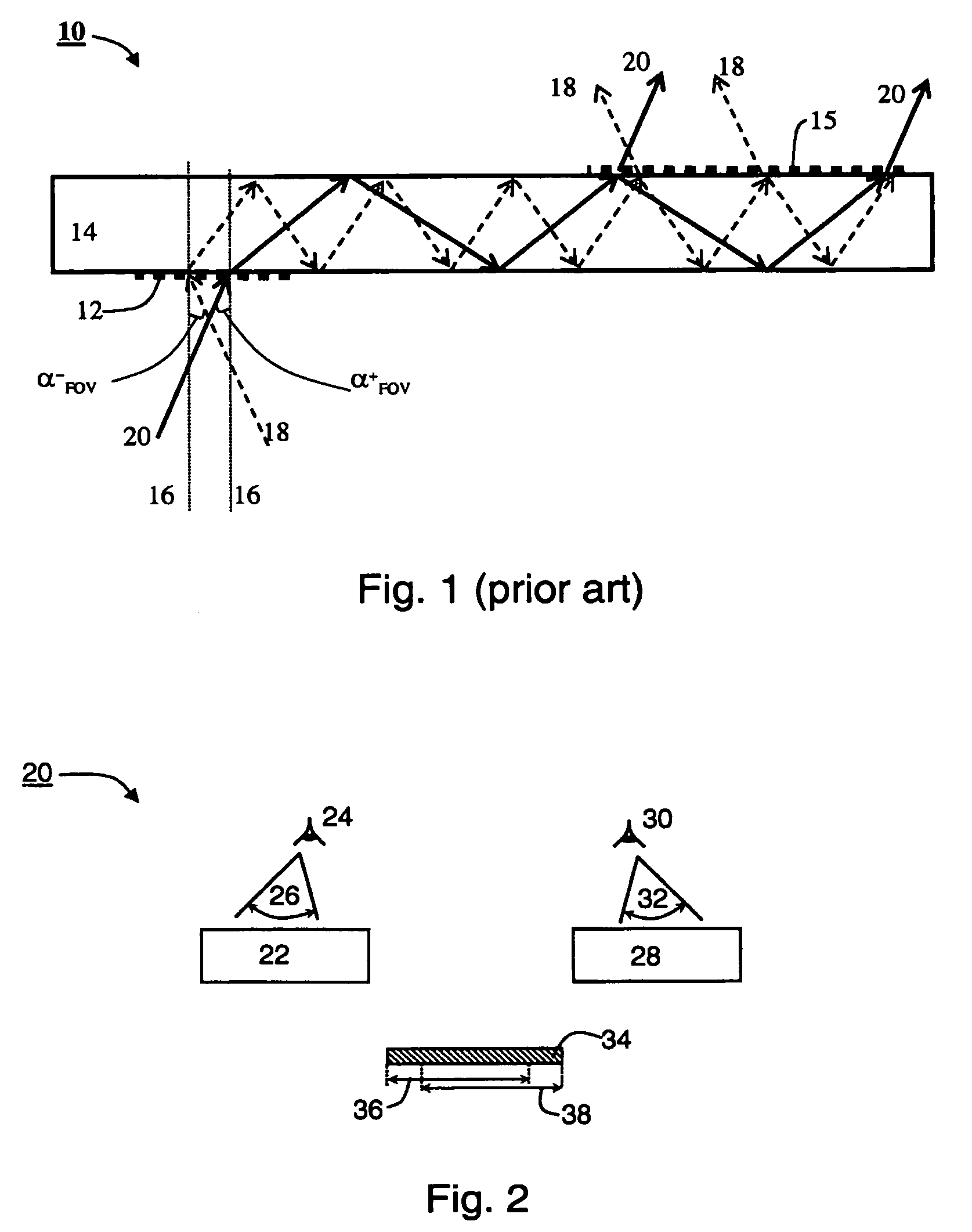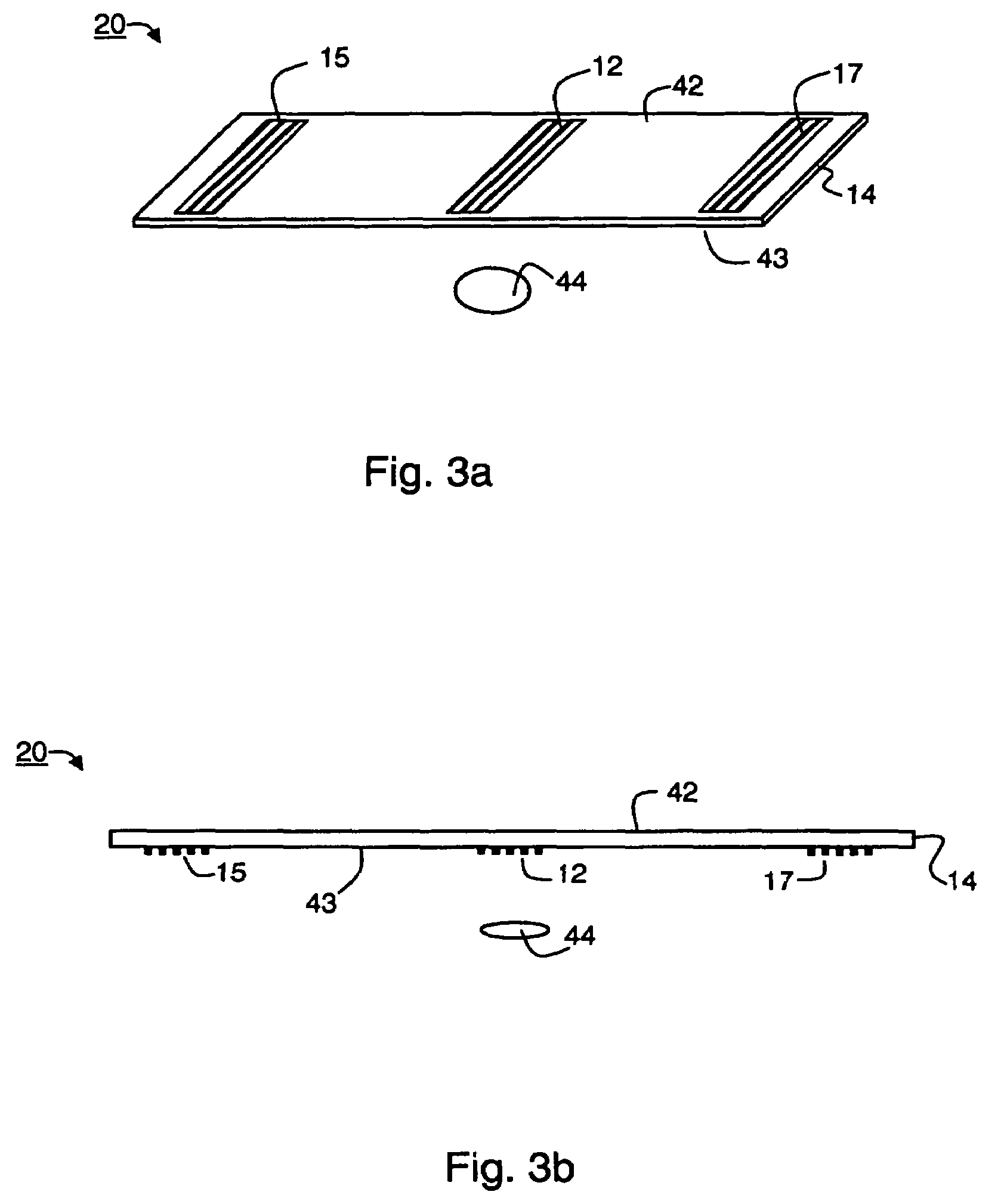Wide field-of-view binocular device, system and kit
a binocular device and wide field of view technology, applied in the field of binocular devices, systems and kits, can solve the problems of not being able to easily miniaturize, heavy crt display, and inability to view sharp images at a closer distance,
- Summary
- Abstract
- Description
- Claims
- Application Information
AI Technical Summary
Benefits of technology
Problems solved by technology
Method used
Image
Examples
example 1
Monochromatic Configuration for Blue Light
[0268]This example demonstrate the attainable field-of-view when Equation 3 is employed for a wavelength λ=465 nm (blue light), and indices of refraction nS=1.5 for the light-transmissive substrate and nA=1.0 for air, corresponding to a the critical angle is 41.8°.
[0269]For a grating period d=430 mn (λ / d>1, see Equation 3), the maximal (negative by sign) angle at which total internal reflection can be occur is 4.67°. In the notation of FIG. 6a, αI+−=−4.67° (see ray 53). However, the positive incidence angle (see ray 51 of FIG. 6a) can be as large as αI−−=23.32°, in which case the diffraction angle is about 80°, which comply with the total internal reflection condition. Thus, in this configuration, each of the attainable asymmetric field-of-views is of |αI++|+αI−−≈28°, resulting in a symmetric combined field-of-view of 2×αI−−≈47°.
example 2
Monochromatic Configuration for Red Light
[0270]This example demonstrate the attainable field-of-view when Equation 4 is employed for a wavelength λ=620 nm (red light) and the refraction indices of Example 1, corresponding to the same critical angle (αc=41.8°).
[0271]Imposing the “flat” requirement and a maximal diffraction angle of 80°, one can calculate that for λ=620 nm the, grating period of Example 1 d=430 nm complies with Equation 4.
[0272]The maximal (positive by sign) angle at which total internal reflection can occur is 2.03°. In the notation of FIG. 6b, αI−+=+2.03° (see ray 52). The negative incidence angle (see ray 54 of FIG. 6b) is limited by the requirement |αD++|c, which corresponds to αI++=−26.22°. Thus, in this configuration, each of the attainable asymmetric field-of-views is of about 28°, resulting in a symmetric combined field-of-view of about 52°.
example 3
Multicolor Configuration
[0273]This example demonstrate the attainable field-of-view when Equation 6 is employed for a spectrum in which the shortest wavelength is λB=465 nm (blue light) and the longest wavelength is λR=620 nm (red light). The refraction indices, the critical angle and the maximal diffraction angle are the same as in Example 2.
[0274]Using Equation 6, one obtains d=438 nm. Further, using Equation 2 one can calculate the asymmetric field-of-views of the blue and red lights.
[0275]Hence for the blue light the first asymmetric field-of-view is [−3.54°, 24.56°], the second asymmetric field-of-view is [−24.56°, 3.54°], resulting in a combined field-of-view of about 49°.
[0276]For the red light, the calculation yield an opposite situation in which the first asymmetric field-of-view is [−24.56°, 3.54°], and the second asymmetric field-of-view is [−3.54°, 24.56°], still resulting in a combined field-of-view of about 49°.
[0277]If a third, intermediate wavelength is present, say ...
PUM
 Login to View More
Login to View More Abstract
Description
Claims
Application Information
 Login to View More
Login to View More - R&D
- Intellectual Property
- Life Sciences
- Materials
- Tech Scout
- Unparalleled Data Quality
- Higher Quality Content
- 60% Fewer Hallucinations
Browse by: Latest US Patents, China's latest patents, Technical Efficacy Thesaurus, Application Domain, Technology Topic, Popular Technical Reports.
© 2025 PatSnap. All rights reserved.Legal|Privacy policy|Modern Slavery Act Transparency Statement|Sitemap|About US| Contact US: help@patsnap.com



